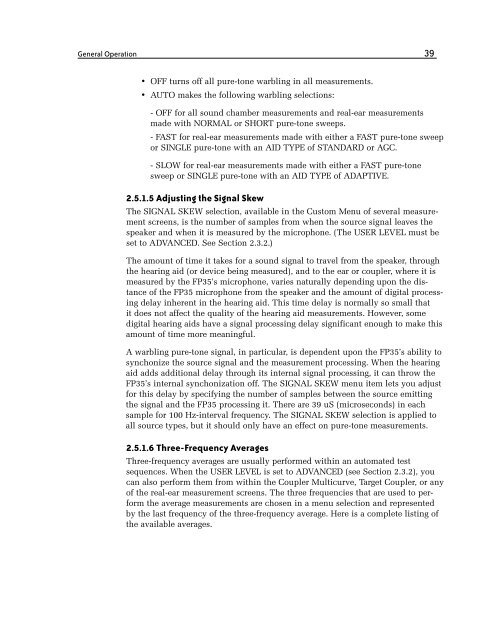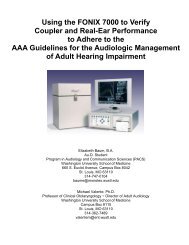FONIX® FP35 Touch - Frye Electronics
FONIX® FP35 Touch - Frye Electronics
FONIX® FP35 Touch - Frye Electronics
You also want an ePaper? Increase the reach of your titles
YUMPU automatically turns print PDFs into web optimized ePapers that Google loves.
General Operation 39<br />
• OFF turns off all pure-tone warbling in all measurements.<br />
• AUTO makes the following warbling selections:<br />
- OFF for all sound chamber measurements and real-ear measurements<br />
made with NORMAL or SHORT pure-tone sweeps.<br />
- FAST for real-ear measurements made with either a FAST pure-tone sweep<br />
or SINGLE pure-tone with an AID TYPE of STANDARD or AGC.<br />
- SLOW for real-ear measurements made with either a FAST pure-tone<br />
sweep or SINGLE pure-tone with an AID TYPE of ADAPTIVE.<br />
2.5.1.5 Adjusting the Signal Skew<br />
The SIGNAL SKEW selection, available in the Custom Menu of several measurement<br />
screens, is the number of samples from when the source signal leaves the<br />
speaker and when it is measured by the microphone. (The USER LEVEL must be<br />
set to ADVANCED. See Section 2.3.2.)<br />
The amount of time it takes for a sound signal to travel from the speaker, through<br />
the hearing aid (or device being measured), and to the ear or coupler, where it is<br />
measured by the <strong>FP35</strong>’s microphone, varies naturally depending upon the distance<br />
of the <strong>FP35</strong> microphone from the speaker and the amount of digital processing<br />
delay inherent in the hearing aid. This time delay is normally so small that<br />
it does not affect the quality of the hearing aid measurements. However, some<br />
digital hearing aids have a signal processing delay significant enough to make this<br />
amount of time more meaningful.<br />
A warbling pure-tone signal, in particular, is dependent upon the <strong>FP35</strong>’s ability to<br />
synchonize the source signal and the measurement processing. When the hearing<br />
aid adds additional delay through its internal signal processing, it can throw the<br />
<strong>FP35</strong>’s internal synchonization off. The SIGNAL SKEW menu item lets you adjust<br />
for this delay by specifying the number of samples between the source emitting<br />
the signal and the <strong>FP35</strong> processing it. There are 39 uS (microseconds) in each<br />
sample for 100 Hz-interval frequency. The SIGNAL SKEW selection is applied to<br />
all source types, but it should only have an effect on pure-tone measurements.<br />
2.5.1.6 Three-Frequency Averages<br />
Three-frequency averages are usually performed within an automated test<br />
sequences. When the USER LEVEL is set to ADVANCED (see Section 2.3.2), you<br />
can also perform them from within the Coupler Multicurve, Target Coupler, or any<br />
of the real-ear measurement screens. The three frequencies that are used to perform<br />
the average measurements are chosen in a menu selection and represented<br />
by the last frequency of the three-frequency average. Here is a complete listing of<br />
the available averages.
















